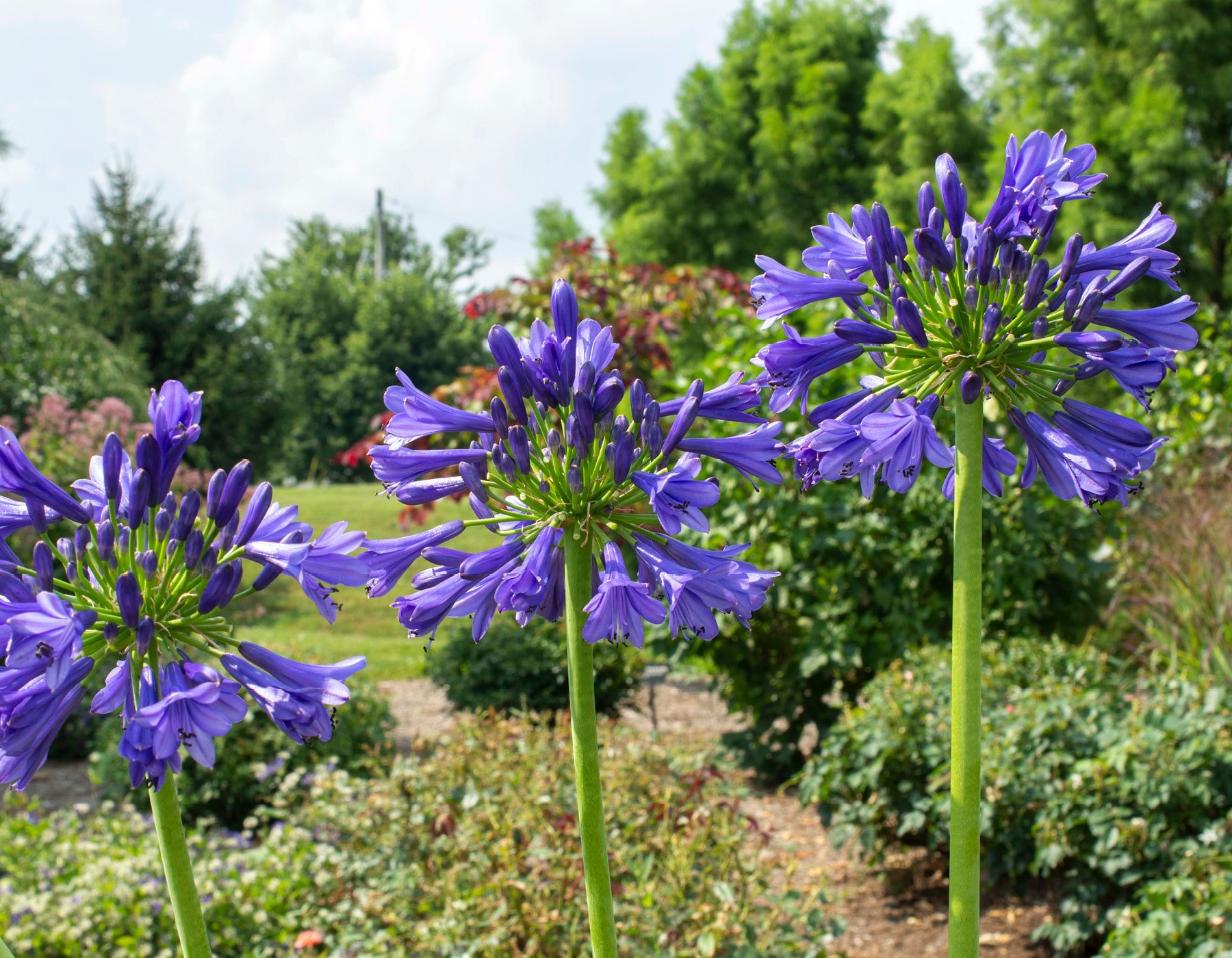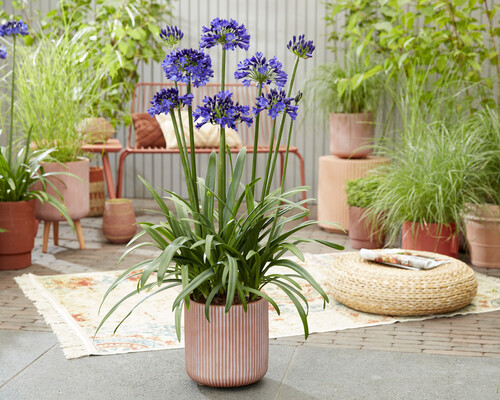Agapanthus Varieties: Selecting the very best for Your Landscape
Agapanthus Varieties: Selecting the very best for Your Landscape
Blog Article
Letting Loose the Secret to Effective Agapanthus Cultivation: Advice for a Flourishing Garden
In the realm of horticulture, cultivating agapanthus successfully needs a strategic approach that incorporates various aspects of plant treatment. By comprehending the subtleties of agapanthus cultivation, one can develop an atmosphere where these plants flourish and grow abundantly.
Growing Agapanthus: Best Practices
When growing Agapanthus, appropriate soil prep work is vital for guaranteeing successful development and growth of these beautiful blossoms. Agapanthus, frequently called Lily of the Nile or African lily, grows in well-draining soil with a somewhat acidic to neutral pH level - Agapanthus. Prior to growing, it is vital to amend hefty clay dirts with raw material such as garden compost or peat moss to boost drain and provide necessary nutrients for the plants
To grow Agapanthus, pick an area that obtains full sunshine to partial shade, as this will certainly promote healthy development and abundant blooming. Dig a hole twice the size of the plant's origin ball and position the Agapanthus at the exact same deepness it was previously growing. Carefully backfill the opening with soil, pushing down securely to remove any type of air pockets around the origins.
Water the newly planted Agapanthus extensively and proceed to keep the soil evenly damp, especially throughout the plant's energetic expanding season. Agapanthus. Using a well balanced fertilizer once a month can additionally sustain the plant's development and flowering. By complying with these best practices for growing Agapanthus, you can develop a stunning screen of these exciting blossoms in your garden
Ideal Soil Issues for Agapanthus
For optimum development and growing success of Agapanthus plants, making sure the dirt problems are suitable is vital. Agapanthus grows in well-draining dirt with a slightly acidic to neutral pH degree varying from 6.0 to 7.0. This sort of dirt permits appropriate water drain, avoiding waterlogging which can lead to root rot. To improve soil drain, think about adding organic issue such as compost or peat moss when preparing the planting site. Furthermore, Agapanthus likes soil that is rich in nutrients, so incorporating a well balanced fertilizer during the expanding period can promote healthy and balanced development and dynamic blossoms.

Watering and Feeding Tips
To ensure healthy growth and vibrant flowers, appropriate watering and feeding methods are essential for successful Agapanthus growing. Agapanthus plants gain from normal watering, particularly during the expanding period. It is recommended to water deeply when a week, making certain the soil is damp however not soaked. Throughout warm climate or in pots, even more regular watering may be necessary to prevent the soil from drying entirely.
When it pertains to fertilizing Agapanthus, a well balanced plant food with equivalent components nitrogen, phosphorus, and potassium can be applied in the springtime to advertise healthy and balanced growth and flowering. Slow-release plant foods are suitable for supplying nutrients slowly over an extended duration. Prevent over-fertilizing, as this can lead to too much vegetation development at the expenditure of flowers.
Additionally, including natural issue like compost right into the soil can enhance nutrient degrees and enhance dirt framework, aiding in the total wellness of the Agapanthus plants. By complying with these watering and fertilizing ideas, gardeners can guarantee their Agapanthus plants prosper and produce sensational displays of blossoms.
Pruning and Deadheading Strategies
Proper trimming and deadheading strategies play a vital function in keeping the health and wellness and visual appeals of Agapanthus plants, complementing the necessary practices of watering and feeding for successful growing. Trimming Agapanthus entails removing invested flower heads, yellowing or dead fallen leaves, and overall shaping of the plant to promote far better growth. Deadheading, the procedure of eliminating discolored flowers, not only enhances the plant's look but likewise urges further flowering.
When deadheading Agapanthus, it is advisable to clip off the blossom stem at the base using sharp, tidy shears. This procedure reroutes the plant's power from seed production back into root and foliage development, advertising a healthier and more durable plant. Routine deadheading can expand the flowering duration of Agapanthus and stop self-seeding, which can bring about overcrowding.
In regards to pruning, Agapanthus normally gain from a light trim after blooming to clean the plant and encourage fresh growth. Cutting down the spent flower stems and getting rid of any check here type of damaged or dead foliage assists preserve the plant's vigor and overall look. However, it is necessary to prevent reducing right into the crown of the plant, as this can damage its wellness.

Protecting Agapanthus From Pests and Diseases
Implementing effective parasite and illness administration methods is vital to protecting the health and vigor of Agapanthus plants in growing. Agapanthus are generally durable plants, but they can still fall victim to numerous parasites and illness if not effectively cared for. One usual pest that affects Agapanthus is the Agapanthus borer, a caterpillar that passages into the plant, causing damages to the leaves and flowers. To stop infestations, routine evaluation of the plants is essential. If borers are discovered, they can be by hand eliminated, or insecticidal soap check this can be utilized as a control action.
In addition to pests, Agapanthus are susceptible to diseases such try this web-site as root rot and fungal fallen leave places. By remaining alert and resolving pest and illness issues quickly, garden enthusiasts can assist their Agapanthus grow and prosper.

Verdict
Finally, effective growing of agapanthus needs proper planting strategies, suitable soil problems, appropriate watering and fertilizing, regular pruning and deadheading, and defense from pests and illness. By complying with these tricks and pointers, gardeners can ensure a prospering garden loaded with lovely agapanthus blooms. Agapanthus. Keep in mind to keep regular care and interest to information to advertise the health and wellness and durability of these magnificent plants
When growing Agapanthus, correct dirt preparation is necessary for guaranteeing effective growth and advancement of these lovely flowers.Water the freshly grown Agapanthus thoroughly and proceed to keep the dirt uniformly wet, specifically during the plant's active growing season.For ideal growth and blooming success of Agapanthus plants, ensuring the dirt conditions are excellent is important. When growing or transplanting Agapanthus, ensure the soil is well-prepared to supply the necessary foundation for the plants to develop themselves efficiently. One usual pest that affects Agapanthus is the Agapanthus borer, a caterpillar that tunnels into the plant, creating damages to the flowers and leaves.
Report this page